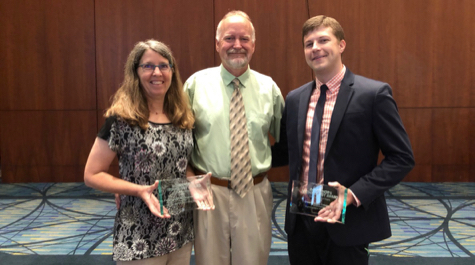VIMS teams win suite of Governor's Technology Awards
StormSense and WetCAT enhance delivery and efficiency of citizen services
Two research teams from William & Mary’s Virginia Institute of Marine Science today received 2019 Governor’s Technology Awards for developing online tools that allow users to track water levels in real time throughout Hampton Roads, and to assess the health of the Commonwealth’s coastal wetlands.
Predictions for coastal flooding from Hurricane Dorian on the day following the awards ceremony highlight the importance of the teams’ work to the citizens of Hampton Roads and the Chesapeake Bay region.
“Virginia is committed to using technology to improve the efficiency of government, enhance the quality of service to our citizens, and ensure public dollars are spent effectively,” said Virginia Gov. Ralph Northam in a release. “The awards program allows us to showcase public-sector innovation for the benefit of all Virginians.”
VIMS Dean and Director John Wells says, “These awards recognize our long and continuing history of collaboration with private and public partners and are a special honor given this year’s fierce competition.”
StormSense
Derek Loftis, an assistant research scientist in the Center for Coastal Resources Management at VIMS, shared a pair of awards with his municipal partners for StormSense, an online platform for real-time monitoring of water levels in Newport News, Norfolk, Portsmouth and Virginia Beach.
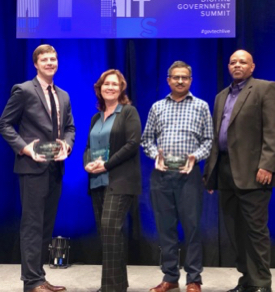 StormSense received the award for "Cross-Boundary Collaboration on IT Service Delivery Initiatives," while StormSense Alerts — which automatically issues a warning to users when waters in Newport News reach levels of concern — earned the award for "Innovative Use of Technology in Local Government."
StormSense received the award for "Cross-Boundary Collaboration on IT Service Delivery Initiatives," while StormSense Alerts — which automatically issues a warning to users when waters in Newport News reach levels of concern — earned the award for "Innovative Use of Technology in Local Government."
StormSense also plays a key role in the "Best Citizen Portal" award won by Newport News. The city’s real-time water-level map ingests data from both the StormSense platform and VIMS’ Tidewatch network.
“We’re thrilled and grateful to be recognized with these awards,” says Loftis. “I’d like to congratulate all the project partners, and thank them for their commitment to dedicating resources in each community to help address flooding resiliency.”
Pedro Wallace, chief information officer for Virginia Beach and a StormSense partner, calls the governor’s awards “a great win for regionalism.”
WetCAT
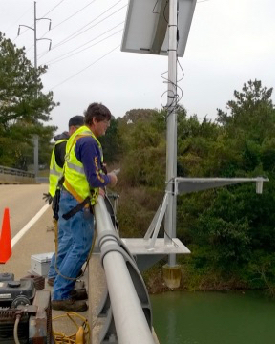 Also earning a governor’s award was the Virginia Wetland Condition Assessment Tool, another product from the Center for Coastal Resources Management at VIMS. Developed in partnership with Virginia DEQ and with support from EPA Region III, “WetCAT” won in the category of “IT as Efficiency Driver - Government to Citizen.”
Also earning a governor’s award was the Virginia Wetland Condition Assessment Tool, another product from the Center for Coastal Resources Management at VIMS. Developed in partnership with Virginia DEQ and with support from EPA Region III, “WetCAT” won in the category of “IT as Efficiency Driver - Government to Citizen.”
Kirk Havens, CCRM assistant director, says, “It’s a real honor to receive the Governor’s Technology Award.” He describes WetCat as a “versatile online tool that lets the public and managers assess wetland condition, support planning, and provide information for policy development,” and says it “allows users to look at wetlands in the landscape, determine their stress levels, and link to impaired waters and other resources.”
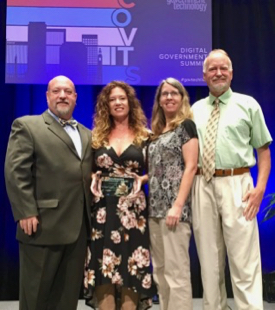 In remarks during the awards ceremony at the Richmond Convention Center, Dave Davis of the Virginia Department of Environmental Quality said, “A unique aspect of WetCAT is that it links the science, policy, and management of wetland resources into one useful, online tool for agencies and citizens of the Commonwealth.” Davis directs DEQ’s Office of Wetlands & Stream Protection.
In remarks during the awards ceremony at the Richmond Convention Center, Dave Davis of the Virginia Department of Environmental Quality said, “A unique aspect of WetCAT is that it links the science, policy, and management of wetland resources into one useful, online tool for agencies and citizens of the Commonwealth.” Davis directs DEQ’s Office of Wetlands & Stream Protection.
Tami Rudnicky, a senior GIS programmer with CCRM, adds, “An exciting aspect of WetCAT is that it’s not a static map but rather an interactive, constantly updated mapping tool that can help users assess wetland stresses at multiple scales.”
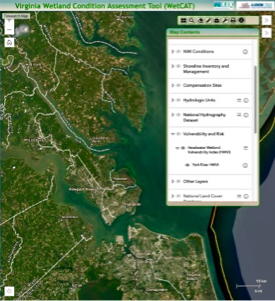 This year’s honors mark the second time this decade that VIMS has earned a technology award from the Commonwealth’s highest office. In 2011, a team led by VIMS Professor Harry Wang was an inaugural winner in the category of “Innovative Use of Modeling & Simulation Techniques.” Wang’s team was recognized for developing a cutting-edge computer model for predicting storm-tide flooding of the Chesapeake Bay shoreline during hurricanes and nor’easters. That model now underlies VIMS’ Tidewatch Map.
This year’s honors mark the second time this decade that VIMS has earned a technology award from the Commonwealth’s highest office. In 2011, a team led by VIMS Professor Harry Wang was an inaugural winner in the category of “Innovative Use of Modeling & Simulation Techniques.” Wang’s team was recognized for developing a cutting-edge computer model for predicting storm-tide flooding of the Chesapeake Bay shoreline during hurricanes and nor’easters. That model now underlies VIMS’ Tidewatch Map.
This year’s governor’s awards were presented on Sept. 5 in Richmond during the Commonwealth of Virginia’s Innovative Technology Symposium, an annual meeting of senior-level executives and technology decision-makers from state and local government, business, and education. Northam kicked off the symposium, which provides opportunities to identify, discuss and propose solutions to Virginia’s critical technology issues.
 Skip to main content
Skip to main content

